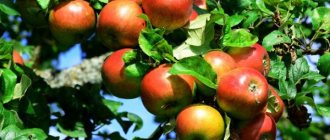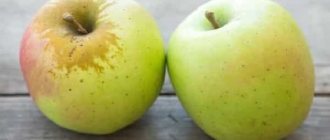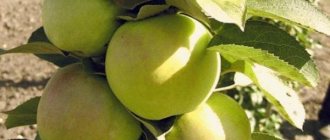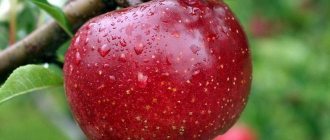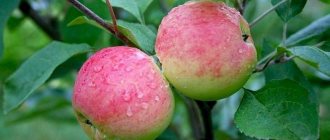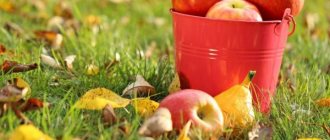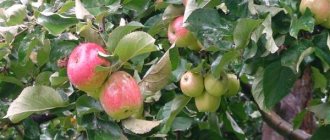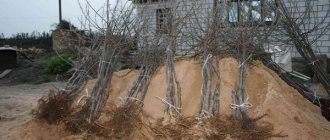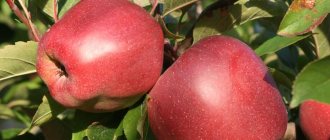Before we begin to describe this subspecies of apple tree, it is worth considering the history of the appearance of this crop. The Cortland apple tree appeared in 1898, thanks to the work of breeding scientists from the New York Experiment Station. The subspecies was bred by crossing varieties such as McIntosh and Ben Davis. In our country, the Cortland apple tree variety became known in the second half of 1915, although by this time it had already gained quite wide popularity in Europe and America. Below we will consider in more detail about this variety of apple tree, as well as all its pros and cons, and the rules of agricultural technology.
Cortland apple tree: variety description and characteristics
Cortland apples: photo of variety
The Cortland apple tree has a fairly tall trunk with a smooth surface and brown and brownish bark. The crown of this fruit tree is endowed with a lush and spreading appearance; from the outside it resembles a rather voluminous circle. The shoots of the Cortland apple tree are straight, medium-length, dark cherry in color, and slightly pubescent. The leaves are not long at all, pointed. The entire surface of the leaf is covered with grooves and veins. These leaves have a heterogeneous color. The upper part of the leaf blade has a pale green tint, and the lower part is endowed with the most whitish color.
The Cortland apple tree has small peduncles that are pure white with a slight pinkish tint. A distinctive feature of the peduncles of this apple tree variety is the formation of inflorescences in groups of about 6-9 pieces, starting from the second half of May until the arrival of June. Also, these flower stalks are endowed with a pleasant honey aroma, due to which a large number of bees flock to them.
The apple tree of this variety begins its first fruiting period five years after planting. Although, if this seedling was purchased on a medium-sized rootstock MM-106, then the tree can begin to bear fruit much earlier. The first harvest from these apple trees can begin 4 years after planting the seedling.
The fruits of the Cortland apple tree have a round, slightly flattened shape. The size of each such fruit is relatively average. One apple can weigh about 140 grams when ripe. The surface of the fruit is covered with a rather thin and smooth skin, which has a slight bluish-waxy coating.
Depending on the stage of ripening, the shade of the fruit may change. For example:
- At the beginning of ripening, the fruits have a green tint to the skin, with a slight presence of gray.
- In the middle of its ripening, the fruits have a predominantly yellow-lemon color with a slight visible waxy coating.
- When the fruits are fully ripened, obvious streaks of red tint are formed on the yellow-lemon surface, with no waxy coating.
The peduncle of the Cortland apple tree variety is small in size and has a large depression. The seed chambers of the fruits are quite wide; they contain large, brownish-colored seeds. The inside of the fruit has a white tint with a subtle pinkish tint near the skin. This pulp is quite juicy and has a dense structure.
additional characteristics
The trees are tall, fast-growing, reaching a height of 5-6 m without pruning. The bark is smooth, brown-brown in color.
The crown is wide-pyramidal, dense, rounded.
The shoots are pubescent, with a dark, almost black tint. The fruits are formed on the ringlets.
The leaves are dark green, the upper part of the leaf blade is shiny, the lower part is gray-green, matte.
The flowers are small, white and pink, collected in inflorescences. The anthers are located above the stigma of the pistil.
The fruits are round, medium in size, weighing 95-130 g. The stalk of a mature fruit remains green. The skin is smooth, during the period of consumer maturity it acquires a crimson-ruddy color with blurred stripes and a bluish waxy coating.
The pulp is sweet-sour, juicy, aromatic.
Taste characteristics of Cortland apples
When tasting Cortland apples, they were awarded 4.5 points (on a five-point scale), which was quite expected, judging by the huge number of reviews from farmers and gardeners who have been cultivating this subspecies in their gardens for quite a long time. Such fruits have a sweet taste with a small amount of sourness, as well as an unusually rich and pleasant aroma. It is also worth noting that these apples have a universal purpose; they are consumed both fresh and used for making ciders, juices, vinegars, marmalade, jam and preserves. These fruits are widely used in the production of dried fruits.
Reviews
Anastasia. “We have been growing this variety of apple tree for 10 years, it tolerates winter well, we harvest it every year. The apples are very tasty and juicy. We store them in our basement until spring, they don’t fade and the taste doesn’t change. We also want to plant this variety grafted onto a dwarf rootstock. They say that then the apples taste even better.”
Alexander. “I have a dacha not far from the river, so all the trees die within 4-5 years, apparently reaching the water level. I was recommended the dwarf variety Cortland. I looked at the photo and description of the variety and bought it. The tree has grown small, now about 2.5 m. The harvest was 2 apples in the third year. But how delicious these apples are! I recommend it to all gardeners."
Michael. “This is my favorite variety. Apples have a sweet and sour taste, they are very juicy and crunchy. The juice comes out excellent, and the apples last until spring. I regularly care for the trees: I feed them, trim them, spray them. Then the apple tree will definitely reward you with a bountiful harvest.”
Cortland apple tree: advantages and disadvantages
Cortland apples: photo of variety
Like any other plant and crop, the Cortland apple tree has its advantages and disadvantages, which you should definitely know. The advantages of the variety include:
- High level of taste characteristics.
- Fruiting on a regular basis.
- The ability to store apples for a long time without losing their taste characteristics.
- In adulthood, this apple tree has high decorative properties.
- Fruits of universal use.
The disadvantages of the Cortland apple tree variety include an average level of frost tolerance, as well as a predisposition to fungal diseases, such as scab and powdery mildew. Although it is possible to prevent the occurrence of fungal diseases on this tree, thanks to timely preventive actions. But it is worth noting that in no case should these plants be treated during flowering.
Cortland apple tree on a low-growing rootstock
Caring for and harvesting tall apple trees is difficult. The optimal solution may be to plant trees on a low-growing rootstock - dwarf or semi-dwarf. They have a number of advantages:
- tree height does not exceed 3 m;
- earlier fruiting - in the second or third year;
- compact planting saves space in the garden;
- it is allowed to plant seedlings on soils with close groundwater;
- the fruits are larger and tastier than those of vigorous apple trees.
Cortland apple tree: planting and care
For cultivating the Cortland apple tree, the best conditions will be the correct choice of site for growth and, directly, the area of its future cultivation.
The Cortland apple tree is endowed with an average level of cold tolerance, which is why it is necessary to take this fact into account when growing in a particular region. This tree grows and develops well in the Lower Volga region, the Caucasus, Donbass and the Republic of Crimea. It will also be quite quick to grow this apple tree in the Baltic countries and Belarus, but only on standard trees.
Compliance with agrotechnical standards and proper, timely care of this tree can lead to a tasty and high-quality harvest.
As already mentioned, it is very important before planting a Cortland apple tree seedling to select and prepare the place for its future growth. A tree of this variety needs a lighted area with fertile, sandy or loamy soil with a good level of air permeability. An equally important and mandatory condition is the moisture capacity of the soil, although long stagnation of melt water or the presence of groundwater close to the soil surface (less than two meters) is not at all desirable, otherwise these factors can destroy the plant. If the site of future growth has heavy or poor soil, then in this case it is necessary to enrich the soil. To do this, you should prepare a nutritious substrate. This is done in this way: you need to mix together such components as 300 grams of wood ash, 250 grams of superphosphate, sand, high-moor peat, or humus, the top layer of fertile soil, which was obtained by digging a planting hole.
Before planting, you should first prepare the growing location you have chosen. To do this, several months before landing, the following activities are carried out:
- Digging the soil.
- Loosening the soil.
- Weeding the area from weeds.
- Application of fertilizing.
After all this work is completed, the ground is dug up again, and then the planting hole is prepared. It is worth noting that when planting a seedling of this variety in the spring, the planting hole should be dug in the autumn. If you were unable to prepare the planting hole in the fall, then they begin to prepare it a couple of weeks before the planting date.
The Cortland apple tree seedling should also be prepared before planting. But initially it should be purchased, and experienced gardeners advise taking seedlings 1-2 years old. Young trees should be purchased from certified nurseries, thereby minimizing the risk of purchasing a weak or even diseased seedling. Before planting, you need to thoroughly check the rhizome of the seedling. If you find signs of damage to the skeletal roots, then pruning will be necessary. If the root system has very branched, overgrowing roots, they need to be trimmed by about 15 centimeters. In order for the roots to have good contact with the soil, they should first be dipped in the mash solution. In order to make it, you need to take mullein and clay in equal quantities. Thanks to this action, the tree’s rhizome adapts much faster and takes root in a new place.
Cortland apple tree seedlings are planted in early spring or in the autumn. But according to experts, the best option for such actions would be the spring planting of this tree. When planting this seedling, it is necessary to take into account the fertility and structure of the soil. If fertile soil predominates in the area, a planting hole should be dug measuring 70 by 70 centimeters, and the depth should also be 70 centimeters. With this type of soil, the addition of a nutrient substrate is not required. When you are on a site for planting heavy clay soil, you must first add a nutrient substrate to the planting hole, and the size of such a hole should be one meter by one meter, and the depth should be the same. If there is a sandy type of soil on the site, then a planting hole is dug measuring 100 by 100 centimeters, and the depth is also one meter. You need to add a nutrient substrate to it, and pour a layer of clay of approximately 15 centimeters on its bottom.
When planting several seedlings at the same time, it is necessary to leave a distance of up to five meters between them. This point is very important, since this tree can grow and develop for 70 years or more. The technology for high-quality and correct planting should consist of several stages, these are:
- Preparatory work for the planting hole.
- Introducing a nutrient substrate into the hole, and in a volume of one third of the total size of the hole.
- Digging in the trunk support.
- Carefully place the seedling in the hole in a vertical position, with the rhizome leveled.
- Sprinkling the top layer of soil, followed by compaction.
- Watering the planted seedling (about three buckets of water per plant).
- Applying a layer of mulch to the tree trunk circle.
If the Cortland apple tree seedling is planted correctly, the grafting site will be located 6 centimeters above the soil surface.
In the first years of life, this seedling is watered twice a month. In the case of a dry summer period, before starting to prepare the apple tree for winter, it is necessary to carry out moisture-charging watering (in September). To do this, pour 30 liters of liquid into the tree trunk for each year of its life. So, for example, when a tree is three years old (from the moment of planting), you need to pour 90 liters of water into its trunk circle.
Cortland apples: photo of variety
Let's consider how much fertilizer should be applied to the plant at different periods of its life, for the best growth and development:
- When the plant is 1-2 years old and the circumference of its trunk circle is about two meters, you should add 40 grams of potassium sulfate, 120 grams of superphosphate, 30 grams of urea, 18 kilograms (on average) of compost or manure.
- When the tree is 3-4 years old and the diameter of its trunk circle is 2.5 meters, it is required to add 60 grams of potassium sulfate, 180 grams of superphosphate, 45 grams of urea, 23 kilograms of compost or manure, on average.
- With a five to six year old age and a tree trunk diameter of three meters, you will need 90 grams of potassium sulfate, 270 grams of superphosphate, 65 grams of urea, 35 kilograms of compost or manure.
- 7-8 years after planting and with a trunk circle diameter of 3.5 meters, you need to add 120 grams of potassium sulfate, 360 grams of superphosphate, 90 grams of urea, 45 kilograms of manure or compost.
- 9-10 years after planting and with a trunk circle diameter of 4 meters, 45-50 kilograms of compost or manure, 140 grams of urea, 480 grams of superphosphate and 150 grams of potassium sulfate will be required.
- After 11 years and further, and the diameter of the tree trunk circle is from five meters, it is necessary to add approximately up to 80 kilograms of manure or compost, 240 grams of potassium sulfate, 750 grams of superphosphate, 180 grams of urea.
The Cortland apple tree requires annual pruning. These measures should be carried out on both old and young plants. There are four types of pruning for this tree:
- Formative. This type of pruning is practiced on five-year-old apple trees in order to give the tree crown the correct shape, as well as to increase its illumination.
- Sanitary . With this type of pruning, all improperly growing branches are removed, as well as those that show signs of damage.
- Regulating . This type of pruning can slow down the upward growth of the crop and deprive the tree crown of shading stems.
- Rejuvenating . This procedure is required for old trees. Thanks to it, it is possible to increase the amount of harvest.
When carrying out any type of pruning, one should take into account the fact that the air temperature at this moment must be stable, and the temperature indicator should not be lower than +10 degrees.
For successful wintering of the Cortland apple variety in the last days of September and the first half of October, it is necessary to prepare the plant for the winter period. To do this, add a dry mixture of potassium and superphosphate to the tree trunk. One square meter will require 50 grams of superphosphate and 30 grams of potassium. This mixture must be scattered at a short distance from the tree itself, after which the soil must be dug up using the bayonet of a shovel. Then moisture-charging irrigation is carried out.
Until the leaves completely fall off, it is necessary to treat the crop with this urea. To prepare such a solution, half a kilogram of fertilizer should be diluted in one bucket of water. This treatment is carried out by spraying the leaf. Thanks to this treatment, the likelihood of fungal diseases will decrease, as well as the risk of spider mite attacks in the spring. You should also whitewash the tree, since thanks to it you can protect the plant bark from sudden temperature changes, too bright sunlight, rather cold winds and frost. Whitewashing a tree trunk can also protect the bark from attacks by harmful insects and rodents. The following solution is used as whitewash: 100 grams of copper sulfate and 400 grams of lime are dissolved in 10 liters of water. The surface of the tree trunk should be thoroughly treated with this solution.
The Cortland apple tree belongs to non-self-fertile fruit crops, which is why it requires additional pollination. Since bumblebees and bees will not be able to completely cope with such a process, the farmer needs to take care in advance to create other conditions for pollination. To do this, other subspecies of apple trees, such as Golden Delicious or Boyken, are planted near a tree of this variety. The close proximity of these subspecies to your tree will help you ultimately get a plentiful, high-quality and tasty harvest of ripe fruits.
The Cortland apple variety belongs to the winter varieties, the ripeness of which comes in September. Although there were cases when this apple tree bore fruit in the month of October.
The Cortland apple tree is considered a representative of the category of apple trees with an average level of productivity. Only after 7-8 years of its life does this crop begin to produce a regular and stable harvest of ripe apples. From one such tree you can collect a maximum of 25 kilograms of ripened fruits.
Diseases and pests of the Cortland apple tree
Despite all its positive distinctive features, the Cortland apple tree is not one hundred percent protected from attacks by harmful insects and is not fully immune to fungal diseases. Often this variety of fruit crop can be affected by diseases such as powdery mildew and scab. In order to avoid such a nuisance as scab, a number of measures are taken, such as:
- Feeding with fertilizers based on potassium and phosphorus.
- Carrying out cleaning of leaves and carrion in the autumn.
- Carrying out stripping and whitewashing of tree bark in the autumn.
- Treatment of the plant in the autumn season with a solution of urea and copper sulfate.
- Treatment of wood in the spring with Bordeaux mixture.
In order to prevent and treat this fruit tree from a disease such as powdery mildew, the farmer needs to treat the crop with fungicides, both before and after flowering. The following solutions are suitable for processing: quick, Bordeaux mixture, chorus.
To combat harmful insects, acaricidal drugs such as Karbafos, Inta-Vir, Aktara, Talstar are used.
It should be noted that any processing must be carried out in calm and dry weather, in the morning or evening, and be sure to observe all safety measures.
History of creation
The Cortland apple tree was bred in 1898 in the USA by hybridizing the Ben Bevis and McIntosh varieties. It has become widespread in Europe. Since 1915, Cortland has been cultivated in Russia.
This variety is included in the State Register of Breeding Achievements, zoned in the Lower Volga region , including the Volgograd, Kursk, and Saratov regions, and is grown in eastern Ukraine. It has prospects for cultivation on standard-forming plants in Belarus and the Baltic republics.

